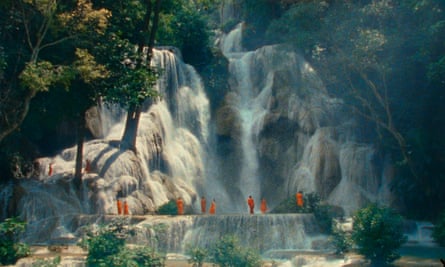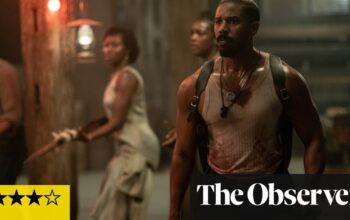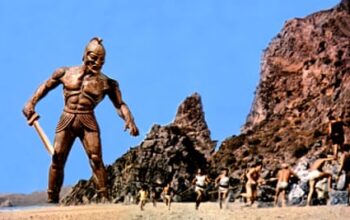L
Juan Patiño had been pondering about apparitions when he conceived the concept of a movie that could be experienced with closed eyes. The filmmaker’s initial two productions, Coast of Death in 2013 and Red Moon Tide in 2020, showcased the coastal terrain of his birthplace Galicia in a hauntingly beautiful manner. Legends, phantoms, and forewarnings of demise revolve around as inhabitants recount tales of shipwrecks, sailors lost at sea, and rumors of a mythical sea creature.
“I have been exploring the concept of contemplative cinema,” explains Patiño, who is 40 years old, regarding his previous projects. “I wanted to delve deeper into the concept of an introspective and meditative experience.” He then started pondering about “the notion of invisibility in film. Eventually, the idea of creating a movie meant to be watched with closed eyes came to mind.”
The title of Samsara is a nod to the Buddhist belief in the cycle of life, death, and rebirth. The story begins in Luang Prabang, located in northern Laos, where a young man regularly visits an elderly woman named Mon who is ill. He reads passages from the Bardo Thodol, also known as the Tibetan Book of the Dead, which is traditionally read aloud to guide the deceased towards their next life. He also spends time with a friend who is studying at a Buddhist monastery and they discuss their aspirations for the future while walking through nature. The monk hopes to study computers while the teenager dreams of becoming a rapper.
After saying goodbye and passing away, Mon expresses her wish to be reborn as an animal. A 15-minute break follows, where viewers are invited to close their eyes and imagine the afterlife journey with Mon. When we open our eyes again, we find ourselves with a family living by the beautiful blue ocean in Zanzibar. A young girl is filled with joy upon seeing a newborn baby goat.

The UK premiere of Samsara took place at the London Film Festival in October, where it was shown at the BFI Imax. The film’s immersive and detailed nature was well-suited for the big screen, allowing for a sensorial experience. The landscapes were showcased in their full grandeur and the sounds were intentionally played at varying levels of intensity. Director Patiño reflected on the premiere the following day, mentioning that the idea for a closed-eye film had been put on hold for a year or two until he discovered the Bardo Thodol. This sparked his interest in exploring how different cultures view the afterlife and their relationship with death. Combining a closed-eye sequence with a story about the afterlife felt like the perfect combination.
He had to make a decision about the locations. He explains that he wanted a Buddhist culture because of the importance of the Bardo Thodol. Laos caught his interest, as its history is not well-known in Spain. He also considered Thailand, but ultimately decided against it due to the meditative and spiritual nature of Thai film-maker Apichatpong Weerasethakul’s work. For the second part of the film, he wanted to showcase a different world, and the idea came to him after being invited to Tanzania for a film workshop. He spent 12 days filming in Luang Prabang and 8 days in Zanzibar, with a crew of three from Spain. The rest of the production team, including camera crew and actors, were locals. He explains that this was due to the film’s low budget and his desire to be respectful. He acknowledges the power dynamic between Europeans and locals and mentions the collaborative nature of the process, where they checked scripts with the crew and actors. He feels fortunate that they trusted him and his intentions. He believes it is important to have open dialogue and curiosity across cultures, rather than solely focusing on one’s own cultural identity, as it can lead to nationalism.
The movie combines elements of both documentary and fiction, weaving together scripted scenes with unscripted moments where individuals express their thoughts and feelings. One notable conversation takes place among women working at a seaweed farm in Zanzibar, discussing their frustrations with the contamination of their crops by water from a nearby hotel. The film also explores themes of death and varying mourning practices, as well as the idea of people being on the cusp of significant changes. Patiño, the director, shares that the young monk in Laos is approaching his 18th birthday, when he will need to decide whether to continue living in the monastery. These stories exemplify the film’s overarching goal of encouraging viewers to reflect on their own choices and consider alternative ways of living. As a director, Patiño hopes to challenge societal norms and expand perspectives on how life can be experienced.
Even when your eyes are closed, the screen during the afterlife interlude in Samsara is constantly changing, filled with bright, flashing lights of various colors and sounds that come and go. Patiño was inspired by James Turrell, an American artist known for his use of light and movement. He describes seeing Turrell’s “Breathing Light” in LA and feeling like he was breathing in and out light. Patiño also mentions Brion Gysin, a British-Canadian artist known for his avant-garde work, specifically his 1959 creation called dreamachine. This was the first piece of art meant to be experienced with closed eyes and consisted of a rotating cylinder with slots, surrounding a lightbulb. As the cylinder spun, the light from the bulb would flicker across the viewer’s closed eyelids.

The audio is divided into two parts. The first part features Xabier Erkizia, the sound artist for the film, interpreting descriptions of the afterlife from the Bardo Thodol. The second part includes recordings from Erkizia’s travels around the world, such as a conversation between a girl and her grandfather in Switzerland and a woman cooking in Timor. These recordings represent places where Mon’s soul is tempted to be reincarnated. Patiño describes this section as “filled with hidden details.”
Patiño’s film, Samsara, is heavily reliant on storytelling. His previous works have bridged the gap between video art and art cinema, often featuring slow-paced landscapes and occasionally abandoning a narrative structure altogether. A review in The Guardian of his film Red Moon Tide noted that some viewers may find the hypnotic pace and spiritual contemplation frustrating. Does the process of creating meditative films hold a certain appeal for Patiño in today’s fast-paced world? He explains that it is more about “exploring my own perspective on physical reality” – similar to how a painter may focus on the intricate details of a landscape.
However, he acknowledges that requesting individuals to shut their eyes for 15 minutes, when they could be viewing 2,000 shots during that time, is a significant demand, almost a form of protest. Nonetheless, there is always at least one person in the audience who approaches him and says, “I will always remember this experience.” Why does he believe that is? Perhaps because suddenly they are prompted to close their eyes in a movie – and they uncover something incredible.
Source: theguardian.com


